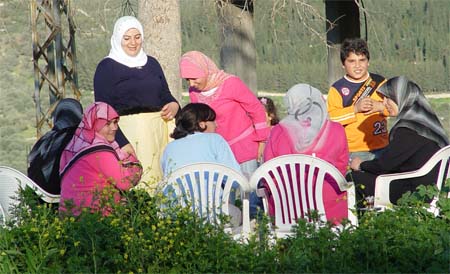
Yesterday, Sunday, Fr Krikor found time away from a busy spring planting agenda at the seminary (50 new trees!) to drive me down to the south of Lebanon, to the ancient cities of Sidon and Tyre.
“Sayd” is the Arabic word for “fishing” or “hunting”, and the fishermen of Sidon have been plying their venerable trade throughout the 6,000 years of Sidon’s history.

The star attraction in the Port of Sidon is the Sea Castle built by the
Crusaders in 1228. The ruins are in fairly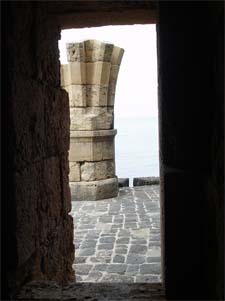 good condition and the stone work is quite wonderful, offering a
glimpse into the golden era in architecture of the High Middle Ages.
good condition and the stone work is quite wonderful, offering a
glimpse into the golden era in architecture of the High Middle Ages.
The castle is built on an island, 80 meters from the shore, on the former site of the temple to Mlkart, the Phoenician Hercules. Sidon makes an early appearance in the Bible, there is a Sidon, the son of Canaan whose city marks the northern frontier of the kingdom of the Canaanites. (Genesis 10.15-17) It is to this region, that Elijah flees seeking refuge from the great famine, taking up residence in the home of the famed “widow of Zarephath of Sidon”.

The Old Port of Sidon, is also the site of Sidons’s
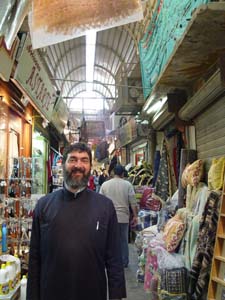 famous souqs, or covered market place.
Sunday is a holiday in Lebanon, and the local Sunni and Shia population takes
advantage of the day off to seek bargains in this most ancient form of shopping
centre.
famous souqs, or covered market place.
Sunday is a holiday in Lebanon, and the local Sunni and Shia population takes
advantage of the day off to seek bargains in this most ancient form of shopping
centre.
My Lonely Planet guidebook sets the scene, “This is the medieval heart of the city where, in labyrinthine alleyways shopkeepers ply their trades in workshops the same way they have done for centuries.” Fr. Krikor has a great sense of direction, and we have a great time exploring the labyrinth.
From Sidon we move on to visit “Our Lady of Manara” in nearby Maghdousheh, located high on a hillside, a few kilometers from the Old Port. There is a cave at Maghdousheh where, according to tradition, the Virgin Mary waited for Jesus while he went to preach in the city of Sidon, hence the name Mantara, which, in the local language, means “the wait.”
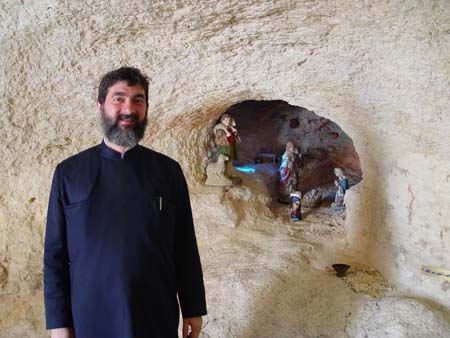
Fr. Krikor has a particular attachment to the site. When his mother was pregnant with him, she promised the Lord that she and her husband would make a pilgrimage to Maghdousheh with the new born baby. So it was that — a few years ago — the infant Jean-Pierre (Fr. Krikor’s given name) was passed from one parent to the other through the tiny opening in the wall of the cave, pictured here.

From Maghdousheh, we drive south, ever deeper into the land of Hezboullah, and further into the nearly 60 year old war zone in the Arab-Iraeli conflict. Politics, as one can see in this photo (above) takes up a lot of space in the lives of the locals. Hezboullah maintains an armed militia, and its political clout is largely based on its long history of standing up to Israel.
The traffic moves reasonably well,
in that crazy Lebanese sort of way. (Why have two lanes when you can easily have
three?) The bottlenecks are invariably caused by one of two things: round abouts
(a.k.a. the automobile jamboree — empahsis on jamming) and the regular military
check points. I express concern that I left my passport at the Catholicosate, to
which Fr. Krikor responds, “What’s to worry! Today, I am your passport.” Before
the authority of our black cassocks and Fr. Krikor’s fluent Arabic, no obstacles
stand in our way.
well,
in that crazy Lebanese sort of way. (Why have two lanes when you can easily have
three?) The bottlenecks are invariably caused by one of two things: round abouts
(a.k.a. the automobile jamboree — empahsis on jamming) and the regular military
check points. I express concern that I left my passport at the Catholicosate, to
which Fr. Krikor responds, “What’s to worry! Today, I am your passport.” Before
the authority of our black cassocks and Fr. Krikor’s fluent Arabic, no obstacles
stand in our way.
Soon we reach the relatively new city of Tyre (ony 5,000 years old compared to Sidon’s 6,000) a few kilometres from the border with “occupied Palestine.” The city is known for its clean beaches, pictoresque harbour, extraordinaty souqs, and breathtaking ruins. It is the latter that draws our attention, and we spend a good hour wandering through the Al-Bass archaelolgical site, with its huge triple-bay triumphal arch, standing on a collonaded street, built by the Romans in the 2nd century A.D.
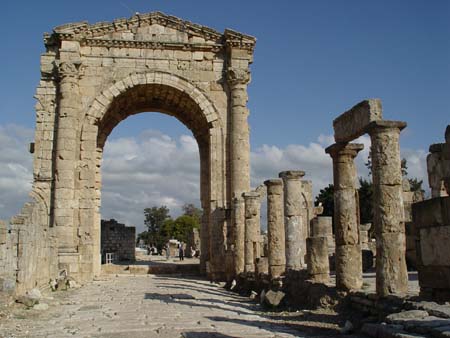
Beyond the arch is “the largest and best preserved Roman hippodrome in the world. 480 meters long, some 20,000 spectators found seats for the dazzlingly dangerous chariot races. The tight turns of the hippodrome (around the metae or turning stone which you can see standing to the right, below) provided the most exciting entertainment, it would seem, causing many spills and collisions — perhaps the model for the Lebanese traffic circle?
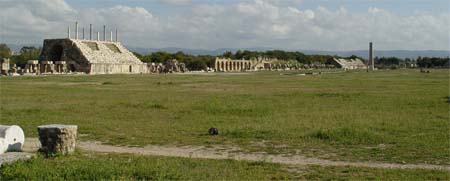
Several groups of locals enjoying a day off in the sun take advantage of the
large parkland of the ruins for picnics and afternoon strolls. I ask Fr
Krikor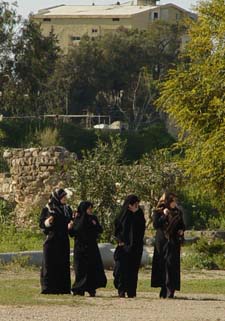 if one can distinguish between
Sunni and Shia Moslems, and he replies that generally not. While Sunni women
tend to be more westernized than their Shia counterparts, they too are known to
wear the veil. These women enjoying the warm springlike weather, however, are
most likely Shia the predominant Moslem group in the city of Tyre.
if one can distinguish between
Sunni and Shia Moslems, and he replies that generally not. While Sunni women
tend to be more westernized than their Shia counterparts, they too are known to
wear the veil. These women enjoying the warm springlike weather, however, are
most likely Shia the predominant Moslem group in the city of Tyre.
Our final destination for the day is the Grotto of Cana, about 20 minutes inland from Tyre. Fr Krikor has visited the Grotto on at least one other occasion, but unsure of his bearings, he asks directions from the agent at the entrance to the archeological park. … and no, this is not a picture of an Orthodox Christian and a Shia Moslem about to strangle each other … just two Lebanese discussing directions with Arabic and the language of hands!
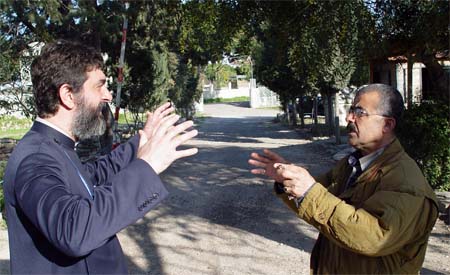
Fr. Krikor is in fact very good about asking directions. It seems it is a family tradition dating at least to his grandfather, a married Armenian priest, who believed that a truly wise man always asks for help in finding his way. And find our way we do, arriving at one of the most splendid natural sites I’ve seen in Lebanon thus far … ostenisbly the side attraction for the Grotto of Cana.

The Lebanese believe that the Grotto of Cana and its neighbouring village,
are the true site of the great first miracle in the Gospel of St. John, the
changing of water into wine. The claim is based on fairly convincing reports
from third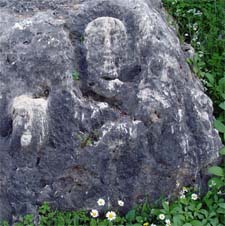 century historian,
Eusebius of Caeserea, and fourth century, St. Jerome. It is maintained that
Jesus, his mother, and his earliest disciples made the journey, along a path way
lining the valley pictured above, from Nazareth to Cana of Tyre. Most
interesting, a series of sculptures, etched into the limestone along the path
leading to the grotto where Jesus and company are said to have spent the night.
These present scenes from the life of Jesus and seem quite old, suggesting that
a very early community of Christians recognized this to be a sacred site,
possilble that of the great miracle of Cana.
century historian,
Eusebius of Caeserea, and fourth century, St. Jerome. It is maintained that
Jesus, his mother, and his earliest disciples made the journey, along a path way
lining the valley pictured above, from Nazareth to Cana of Tyre. Most
interesting, a series of sculptures, etched into the limestone along the path
leading to the grotto where Jesus and company are said to have spent the night.
These present scenes from the life of Jesus and seem quite old, suggesting that
a very early community of Christians recognized this to be a sacred site,
possilble that of the great miracle of Cana.
In the village, we pause to visit “les jarres de Cana” a site claiming to display the broken wine jugs that figure in the story of the wedding of Cana. Of even greater interest, a group of young people from the village having a great time in the sun, dancing and clapping with the yips and high pitched yodles of the Arabic wedding feast.
